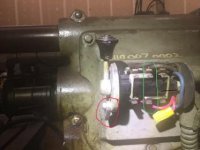View attachment 292262I’m reactivating a Burke No. 4 and everything works except the reverse-running things. Yes the only reason for reversing the motor is to run the table back to the start of a cut. I think it can be pushed back by hand so the reverse isn’t essential but I’d like to have it anyway. Two things show it was intentionally disabled, the center contacts of the reversing switch are not connected (green circle) and a steel stop was added to keep the switch handle from going down to the reverse direction (red circle.) Why would an owner (presumably) or operator disable the reverse function? Mill details if interested:
http://www.vintagemachinery.org/pubs/132/5821.pdf View attachment 292261
What Reggie said about cutters, what Joe said about NOT "climb" milling.
A DC motor for the spindle makes reversing as easy as variable speed, but that's just me and my K-B's

More useful, perhaps?
A reversible - also variable-speed - Dee Cee hollow-shaft Bison (or Bodine) gearmotor mounted back where it replaces the light-duty step-pulleys for driving the universally-jointed traverse-feed shaft.
If you chase that option, you'll still need that rig - shaft and worm. Those motors are too heavy and bulky to mount on the nano-table.
You'd also still need the slotted cover with cam/latch arrangement to be able to engage or drop-out the worm - or have the limit stop in the Tee slot in the front edge of the table kick it out with the pushrod.
ELSE the table cannot be adjusted nor traversed by hand for lack of a dog clutch or the like on the DC Gearmotor.
Previous owner of my one said all he - or his Uncle before him - had done with it for 30 years.. was cut straight or Woodruff keyways.
Nothing else. Didn't even
have the power feed shaft or worm.
In fact, he had been powering it through the TAKE-OFF step pulleys MEANT to be FOR the traverse feed - from a salvaged 1/2 HP Rockwell table-saw motor mounted backwards on the swing plate to line its pulley up with the step-pulley on the arse-end of the spindle.
The main Vee belt sheave had gone "empty" of any belting for ages!
It had been all the power they needed, given they repaired motorized lawn and garden goods with relatively small shafts and keyways!
In its "normal" configuration, a #4 with #9 B&S tooling can do what it does at a higher metal removal rate than a Bridgeport with Are Ate.
It may be small, but it is still a horizontal.
 I’m reactivating a Burke No. 4 and everything works except the reverse-running things. Yes the only reason for reversing the motor is to run the table back to the start of a cut. I think it can be pushed back by hand so the reverse isn’t essential but I’d like to have it anyway. Two things show it was intentionally disabled, the center contacts of the reversing switch are not connected (green circle) and a steel stop was added to keep the switch handle from going down to the reverse direction (red circle.) Why would an owner (presumably) or operator disable the reverse function? Mill details if interested: http://www.vintagemachinery.org/pubs/132/5821.pdf
I’m reactivating a Burke No. 4 and everything works except the reverse-running things. Yes the only reason for reversing the motor is to run the table back to the start of a cut. I think it can be pushed back by hand so the reverse isn’t essential but I’d like to have it anyway. Two things show it was intentionally disabled, the center contacts of the reversing switch are not connected (green circle) and a steel stop was added to keep the switch handle from going down to the reverse direction (red circle.) Why would an owner (presumably) or operator disable the reverse function? Mill details if interested: http://www.vintagemachinery.org/pubs/132/5821.pdf 


